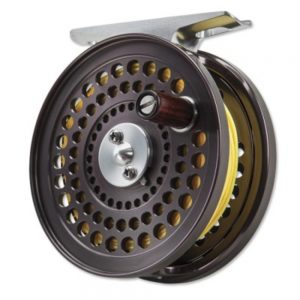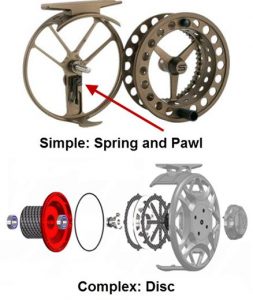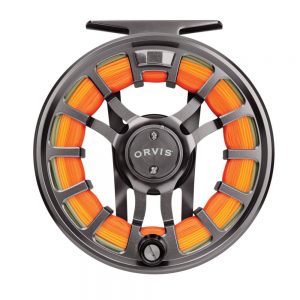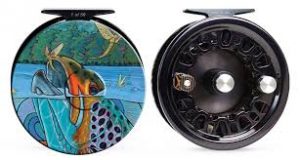
Compared to most spin and bait casting reels, fly reels are pretty simple. Yes, there are always exceptions, but the typical fly reel has a single, direct drive, where one rotation of your hand equals one rotation of the reel. There have, over the years, been multipliers and automatic reels, but all of the extra gears required for them add a significant amount of weight (more on the importance of reel weight later), just to perform a task that usually isn’t necessary.
The drag on a fly reel is also fairly simple. Drag, as it pertains to reels, just refers to the amount pressure the reel puts on the spool as it rotates. In other words, if you’re playing a fish on the reel, when he runs, the reel will apply a preset amount of pressure on him that is determined by your drag setting. Most fly reels will have some version of either a disc drag or a spring and pawl drag.

Disc drags are quieter, apply smoother pressure and allow for significantly more variations in resistance. They are often the choice for fish that may be larger or that make long, strong runs. Spring and pawl drags are lighter in weight and provide a classic “clicking” sound desired by many fishermen. They are often the choice for smaller, lighter rods and when fishing for smaller fish.
More expensive reels, particularly those used in saltwater, tend to have fairly sophisticated drag systems. Orvis had a reel a few years ago that touted a drag system modeled after the brakes used on fighter jets! That’s not a bad thing to have if you’re playing a 150 lb. tarpon, but may be a bit over the top for an 8” Smoky Mountain brook trout! The other thing that significantly impacts the price of a reel is how it is constructed and the material from which it is made.
In addition to possibly plastic components in the drag system, less expensive reels will often be made of a lower grade, softer aluminum that is cast from a mold. This will result in a reel that is a little heavier and a little more prone to denting or bending. In addition to non-corrosive, stainless steel (or similar) drag components, often in a sealed housing, higher end reels will be machined from a high grade, bar stock aluminum. This will result in a reel that is lighter, more resistant to the damages of saltwater, and much more durable.

Another fly reel feature that is becoming more and more common is a larger arbor. Traditionally, fly reels had a very small spindle to which the line attached. A significant amount of backing was put on the reel before attaching the fly line to fill space on the reel. Otherwise, the fly line would come off in smaller, tighter coils and be difficult to keep straight. Mid and large arbor reels are a little wider than traditional reels and have a much larger “spindle.” This not only allows you to retrieve more line in one turn of the reel, but it doesn’t require as much backing. You still want some backing as an “insurance policy” if you hook a bigger fish, but you don’t need 100 yards of it like you did on traditional reels.
If you’re going to be fly fishing in saltwater, the reel is probably THE most important piece of equipment you’ll purchase. However, for most freshwater fly fishing situations, the reel is one of your least important pieces of equipment. Certainly it still has an important function, to store all of your line, but that’s about it. Most of the time when fishing for trout, or bass, or bluegill, you’re going to be playing the fish by hand, stripping the line under the finger on your rod hand to bring the fish in.
So if you’re looking for an outfit for saltwater or even something like salmon or steelhead, and you have a set budget, put as much money in the reel as you can and skimp on the rod. If you’re looking for a freshwater outfit for say, trout or bass, put far less in the reel and more in the rod and line.

However, for many fly fishermen, reels are almost like jewelry. I know guys that fish for nothing but mountain trout and have $600 reels. They think they’re “neat.” Some reels even have elaborate artwork on them to appeal to the “jewelry crowd.” Sometimes we make choices because they’re practical, and sometimes we make choices because they make us happy. If you have the disposable income and want to buy a $600 reel with a drag system that stops fighter jets to put on your 8’ 3-weight trout rod, have at it! But you don’t need to.
Regardless of your budget, there are a couple of things that you’ll want to make sure that you get in a reel. One, make sure it has enough of drag resistance to prevent the reel from ‘free-spooling” when you strip line from it. Second, make sure that the reel is an appropriate size for your line and rod.
Most reel models will come in different sizes for this reason. Heavier fly line weights will take up more space on the reel so you need a bigger reel to accommodate them and the appropriate amount of backing. On a similar note, rods that cast heavier lines weigh more and need bigger, heavier reels to balance them out. Regardless of how heavy or light your fly rod is, if you don’t have a reel that balances it out, it’s going to feel awkward in your hand. It’s much like carrying two buckets of water rather than one. Two buckets might be heavier overall, but will be more comfortable to carry because they balance each other out. You can view the specs on any reel and see what its weight and line capacity is.
